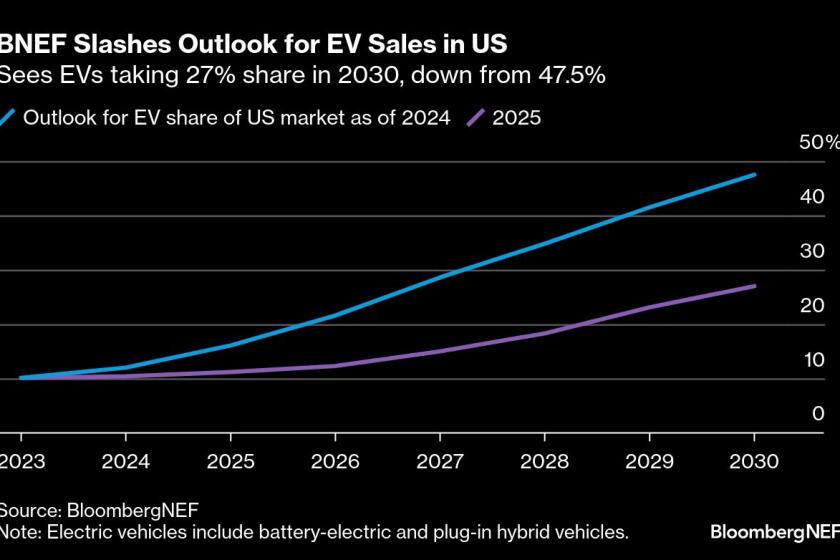Toyota to offer low-cost auto-braking and safety features
- Share via
Toyota Motor Corp. plans to bundle several advanced auto safety features that reduce the frequency of crashes into a low-cost option for its Toyota and Lexus vehicles.
The features alert drivers to a pending collision and trigger the brakes, switch on high beams when there is no oncoming traffic, and warn drivers who drift from their lanes. An upgrade package alerts drivers to potential collisions with pedestrians and also brakes automatically.
The move was lauded by safety experts who eventually want to see the technology become standard equipment on all vehicles.
“The automakers are competing on safety and that’s good news for consumers,” said Russ Rader, spokesman for the Insurance Institute for Highway Safety. “Automatic braking systems are becoming more affordable and they’re worth every penny.”
Automatic braking systems are cutting damage claims for front-into-rear crashes by about 14%, according to the institute. There’s also evidence that the systems are reducing claims for injuries to vehicle occupants, the safety group said.
“Even if the crash isn’t prevented, these systems are reducing the severity of the impact,” Rader said.
The insurance industry research organization spends millions of dollars annually conducting crash tests and analyzing insurance claims data.
The safety options will be introduced across nearly every Toyota and Lexus vehicle sold in the U.S. by the end of 2016. The packages will sell for $300 to $500 for Toyotas and $500 to $635 for Lexus models.
“Anything that makes safety more affordable is a good thing, especially when they are proven safety systems,” said Rosemary Shahan, president of Consumers for Auto Reliability and Safety.
Options like automatic braking systems are slowly making their way into the automotive fleet. Previously they have been expensive options, mostly on models offered by Mercedes-Benz, Acura and other luxury manufacturers.
But other automakers are starting to offer the features. Subaru, for example, has a similar package available for its Legacy sedan as an $1,195 option.
With these packages, Toyota, which accounted for more than 14% of the nation’s auto market with 2.4 million vehicles sold in the U.S. last year, will now make automatic braking “more accessible to buyers of mainstream family cars,” Rader said.
“Pushing these systems across our lineup, as quickly as possible, can help protect people,” said Jim Lentz, president and chief executive of Toyota Motor North America. “More importantly it will help prevent some crashes from ever happening in the first place.”
The packages will be sold as “Toyota Safety Sense” and “Lexus Safety System+” respectively.
The Toyota system will initially be available on the RAV4 crossover and Avalon large sedan and three additional models to be announced later this year. The Lexus package will come out on the RX crossover and four additional models.
“We believe that the ultimate desire of a society that values mobility should be the eventual elimination of traffic fatalities and injuries,” said Bob Carter, senior vice president – automotive operations at Toyota Motor Sales, U.S.A. Inc. “Studies indicate that advanced active safety technologies can have a profound effect on automotive safety.”
The robotic braking technology is such an important feature for traffic safety that Insurance Institute is now requiring that vehicles have it at least as an option in order to qualify for the highest IIHS safety ranking of “Top Safety Pick+.”
Toyota’s system uses a camera and laser radar to detect objects ahead of the vehicle. When the system determines there’s a possibility of collision, it uses audio and visual alerts to ask the driver to brake, and also provides additional braking force to help the driver slow or stop the car.
If the driver fails to brake, the system automatically steps in and slows the car to prevent or mitigate the collision. The operational range covers speeds at which at least 80% of rear-end collisions occur – a range of roughly 7 to 50 mph.
The lane departure alert technology uses a camera to detect visible white and yellow lane markings. When the system detects that the vehicle is starting to deviate from the lane, it alerts the driver.
The package also makes automatic adjustments to the headlights by using a camera to detect the headlights of oncoming vehicles and the taillights of vehicles ahead. It then automatically switches between high beams and low beams to provide the most light but not interfere with oncoming traffic.
An upgraded package combines a camera and millimeter-wave radar for improved performance and reliability, Toyota said. When in cruise control mode, it also can adjust the vehicle’s speed to help maintain a pre-set distance between vehicles. The package also can detect pedestrians.
Follow me on Twitter (@LATimesJerry), Facebook and Google+.




